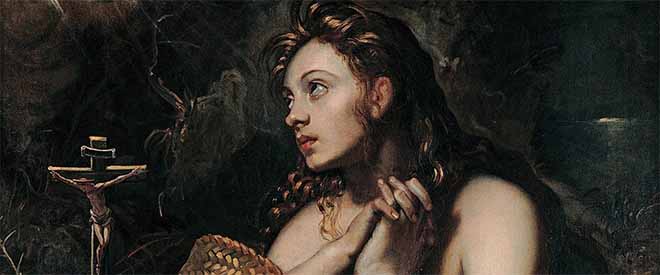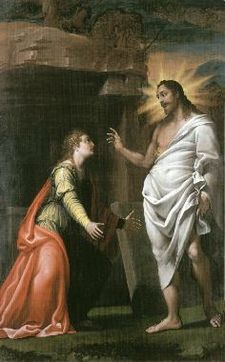Who Was Mary Magdalene
Penitent or Incarnation of the Grail ?

Mary Magdalene is a controversial figure in the Gospels; sometimes anonymous penitent, sometimes the Madeleine, sometimes Mary of Bethany, the many faces of Mary Magdalene makes her an enigmatic emblem of the Bible. According to the Gospel of Peter, the day of the resurrection of Christ, Mary Magdalene was the first to be forewarned by angels.
Who was Mary Magdalene ?
Originally from Israel and more specifically from the city of Magdala on the Galilee sea shore, Mary Magdalene was undoubtedly one of Jesus Christ' followers. She is mentioned so often in the New Testament, even more often than the Virgin Mary, that she was probably in a relationship of equals with Jesus; Mary Magdalene was Jesus' wife or one of his greatest followers. She is of all major events of the Christ' life: crucifixion, burial, resurrection ... In addition to being a main figure of the New Testament, Mary Magdalene also appears in several apocryphal texts as well as in the Epistle of the Apostles. The Gospel of Mary, a Coptic manuscript found in the Akhmim Codex (Museum of Berlin) and dating from the early days of Christianity, recounts her many discussions with Jesus. For evangelist Anne Graham Lotz and theologian Elaine Pagels, Mary Magdalene would've taken the reins of Christendom at the death of Christ.
The many faces of Mary Magdalene

Mary Magdalene is presented by Luke as suffering from severe neurosis and being possessed by seven evil spirits; Jesus Christ acts as a savior and frees her from her demons. The Gospel of John makes Mary of Bethany disappear from the story after the penitent episode where she anoints Jesus' feets during one of his preachings. She only reappears after the death of Christ and then takes the name of Mary Magdalene. For ecclesiastical, the three characters (Mary of Bethany, Mary Magdalene and the penitent) are in fact one and the same person and serve as a symbol of repentant impurity for catholics. The true visage of Mary Magdalene was a thorny point at the time of the Schism of 1054 but since year 1969 she is no longer considered one of Jesus' followers but rather the Holy Mary.
A penitent in exile ?
Many stories claim that after the resurrection of Jesus, Mary Magdalene would've left Palestine in a small boat accompanied by Martha, Saint Lazarus and many other characters. They would have traveled the Mediterranean Sea before docking at Camargue on the French Riviera, where Mary Magdalene would've exiled herself for 33 years in a coastal cave of Sainte-Baume in order to repent. There, she takes her last breath and is buried in a tomb of Saint-Maximin-la-Saint-Baume. Christian legends and the Basilica of Mary Magdalene have made the burial place of the Madeleine an emblematic place, almost as important as the Church of the Holy Sepulchre. However, for many exegetes, the story would be false since the oldest documents speaking of it dates from the tenth century; Mary Magdalene would've never left Palestine and would'nt have died in a cave on the French Riviera.

Wife of Jesus ?
Some ancient writings report that Mary Magdalene and Jesus were carnally united and maybe even married. For experienced exegetes, there is no doubt: Mary Magdalene was Jesus' wife and also the mother of his childrens. At that time, men were all married before their thirties or considered an anomaly, often ostracized. The Christian Church, however, would've portrayed Christ as a lonely being and Mary Magdalene as a penitent in order to outlaw sexual desire.
The incarnation of the Grail
In The Holy Blood and the Holy Grail published in 1982 under the pen of three British journalists, the Holy Grail would not be the cup used by Christ during the Last Supper but rather the posterity of the carnal union between Jesus of Nazareth and Mary Magdalene, the Merovingian dynasty. The Templar Revelation (1997 by Clive Prince and Lynn Picknett) takes the reasoning a bit further and tries to establish a link between Freemasonry, Cathars, Knights Templar and the lineage of Christ. The book utters the idea of a very well kept secret, probably by the Templars, about the true existence of Jesus and his essence. Dan Brown was largely inspired by these two books while writing is now famous The Da Vinci Code (2003) in which he takes these two basic ideas and give life to the character of Robert Langdon.









































































































































































































































































































































